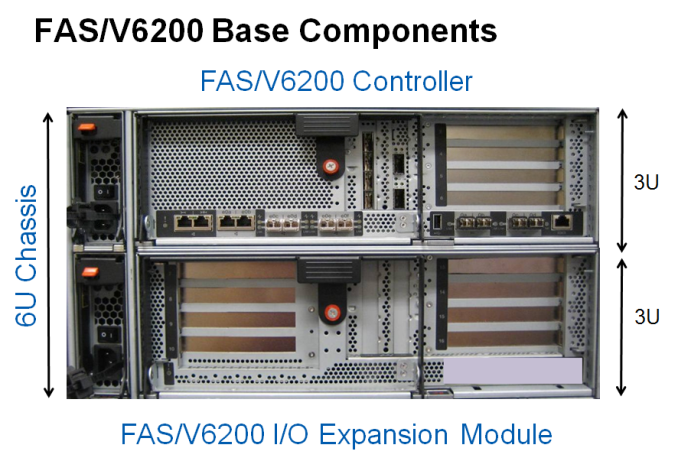The Impact of Disruptive Technologies on the Professional Storage Market
by Johan De Gelas on August 5, 2013 9:00 AM EST- Posted in
- IT Computing
- SSDs
- Enterprise
- Enterprise SSDs
NetApp: Flash Anywhere
Nutanix, CloudFounders/Amplidata, and Fusion-IO (covered on page eight) are clearly challenging the current market leaders NetApp and EMC. We decided to take a closer look at how the giants respond by looking at the latest products of NetApp. NetApp's first step with using flash memory was called “flash cache”. NetApp simply added a PCIe flash card and inserted it into its FAS V6200 storage arrays.
It was a quick way of adding some performance, but it was far from exploiting the true potential of NAND memory. First of all, the flash cache was only used for reads and secondly the cache used a very simple but hardly efficient FIFO eviction algorithm. Case studies (done by NetApp Customers) with applications with a typical read/write mix reported about 30% more IOPs and on average 20% lower response times when arrays with 10K RPM SAS disks where replaced by an array with a massive flash cache and slightly slower 7200 RPM disks.
Considering how large the gap is between flash memory and magnetic disks, and the small gap between 10K and 7.2K RPM disks, that is rather underwhelming. Part of the reason is of course that these arrays already have a healthy amount (4-8GB) of NVRAM (Non Volatile RAM) that caches the hottest data and makes writes more sequential. However, the list price of a flash cache module is anywhere between $16000 (256GB) and $50000 (1TB).
In a published benchmark, six FAS6240 with 192 15K RPM disks (costing $1.5 million in total!) achieved about 250k IOPs, or about 40K IOPs per array. To sum it up: it's a very high premium for an underwhelming but very welcome performance boost. Only customers who use read dominated applications (like warehouse / OLAP app) can really expect excellent performance.











60 Comments
View All Comments
prime2515103 - Wednesday, August 7, 2013 - link
I know, it just seems unprofessional. It's a tech article, not a chat room.FunBunny2 - Tuesday, August 6, 2013 - link
What is always missing from such essays (and this one reads more like a 'Seeking Alpha' pump piece) is a discussion of datastore structure. If you want speed and fewer bytes and your data isn't just videos, then an industrial strength RDBMS with a Organic Normal Form™ schema gets rid of the duplicate bytes. Too bad.DukeN - Tuesday, August 6, 2013 - link
But has there actually been any disruptions to the top dogs?EMC, NetApp, storage from HP/Dell/IBM, Hitachi all have had significant earnings increases yet again.
So maybe a couple of new startups as well as FusionIO are making money now, but some of the big guys can probably just buy them out and shelf them.
davegraham - Tuesday, August 6, 2013 - link
Look at EMC's acquisition of XtremeI/O...that's a viable competitor that EMC has already been able to integrate as a mainstream product. Oh, and they're also using Virident PCIe cards for server-side flash. ;)DukeN - Wednesday, August 7, 2013 - link
But is that really disruptive, or business as usual? These guys usually buy up smaller technologies as needed and integrate them if needed. Most of their core business (spinning disks) has remained the same.bitpushr - Friday, August 9, 2013 - link
XtremIO is still not a shipping product. It is not generally-available. So, I do not think this qualifies as "integrate as a mainstream product".Likewise their server-side Flash sales (Project Lightning) have been extremely slow.
phoenix_rizzen - Tuesday, August 6, 2013 - link
If you ditch Windows on the desktop, you can do a lot more for a lot less.$22,000 for a Nutanix node to support a handful of virtual desktops? And you still need the VDI client systems on top of that? Pffft, for $3000 CDN we can support 200-odd diskless Linux workstations (diskless meaning they boot off the network, mount all their filesystems via NFS, and run all programs on the local system using local CPU, local RAM, local GPU, local sound, etc). The individual desktops are all under $200 (AMD Athlon-II X3 and X4, 2 GB of RAM, onboard everything; CPU fan is the only moving part) and treated like appliances (when one has issues, just swap it out for a spare).
No licensing fees for the OS, no licensing fees for 90+% of the software in use, no exorbitant markup on the hardware. And all staff and students are happy with the system. We've been running this setup in the local school district for just shy of 10 years now. Beats any thin-client/VDI setup, that's for sure.
turb0chrg - Tuesday, August 6, 2013 - link
Another vendor doing hybrid storage is Nimble Storage (http://www.nimblestorage.com/). I've looked at their solution and it is quite impressive. It's not cheap though.They also claim to be the fastest growing storage vendor!
dilidolo - Tuesday, August 6, 2013 - link
I have 2 of them for VDI, they work fine, but I wouldn't call it enterprise storage.equals42 - Saturday, August 17, 2013 - link
It's only iSCSI so you better like that protocol.